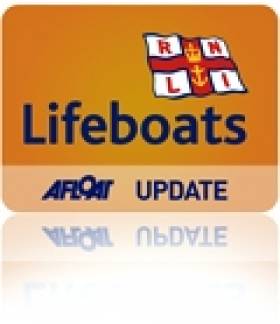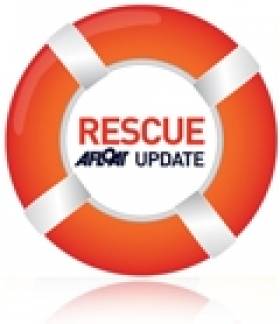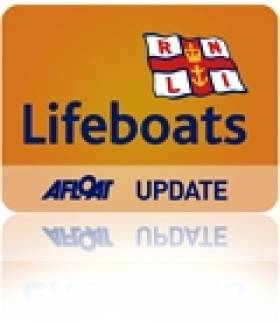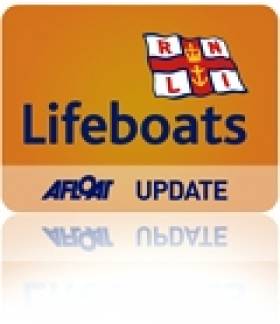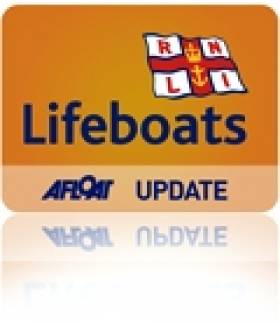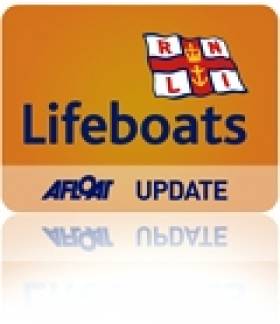Displaying items by tag: RNLI
Portaferry Lifeboat Joins Multi-Agency Search For Missing Woman
#RNLI - Portaferry RNLI's volunteer lifeboat crew were called out yesterday (Wednesday 29 April) to help in the search for a woman reported missing to police.
The RNLI lifeboat, an Inshore Atlantic 85, was launched at 5.05pm and the volunteer crew were on scene, just off Strangford village on the shores of Strangford Lough in Co Down, two minutes later to commence their search of the waters along the shoreline towards the northern end of the lough.
Weather conditions at the time had rain but with good visibility and a Force 4 westerly wind.
The multi-agency search included members of the PSNI, coastguard teams from both Portaferry and Bangor, and Rescue 116, the Irish Coast Guard helicopter dispatched from Dublin.
The volunteer RNLI crew searched Strangford Lough’s western coastline as far north as Salt Island before crossing to the eastern side and searching towards the southern end, through Ballyhenry Bay towards Portaferry and the stretch of water running between Portaferry and Strangford village known as The Narrows.
It was as the volunteer RNLI crew reached Portaferry that they received word to stand down as news came through that the missing woman had been found.
Speaking on behalf of Portaferry RNLI, lifeboat operations manager Brian Bailie said: "It is at times like this that all of the hard work and training our volunteers put in comes to fruition.
"Training with the other emergency and rescue services is essential for all concerned, as today certainly proves."
Six Junior Sailors Rescued In Dun Laoghaire Drama
#Rescue - Independent.ie reports on the dramatic rescue of six young sailing trainees after their dinghy overturned in a gust in Dun Laoghaire harbour yesterday afternoon (Sunday 26 April).
One of Dun Laoghaire RNLI's lifeboats spotted the children in trouble while returning to port from an exercise and helped the six out of the water.
#lifeboat – The RNLI is appealing for Irish yacht sailors who have not yet taken part in the charity's new research project, which is exploring attitudes towards risk and safety, and the various ways in which yacht sailors participate in their sport, to complete the survey before it is finished this Thursday (30 April).
There has been a strong initial take up but the charity is hoping for more respondents in the final days. Every response given will help the RNLI understand why people get involved in sailing and how they behave when they are on the water so we can provide the most relevant and useful safety information to them
The research, which is supported by the Irish Sailing Association (ISA) will look at what motivates sailors, how often they go to sea, their experience and training, awareness of potential hazards and use of safety procedures and equipment. The findings will be used to help develop tailored and relevant safety messages for the yacht sailing community.
An online questionnaire for yacht sailors in Ireland was launched at the end of March and is running for five weeks until 30 April. All of those who participate in yacht sailing who are based in Ireland – no matter how often or what level of experience – are encouraged to take part. The RNLI is asking people to log on to www.rnliyachtingIreland.substance.coop and complete the survey, which will take about 15 minutes.
The survey will also be supplemented by interviews with individual yacht sailors and yachting organisations as well as focus groups held in selected locations. The project will be undertaken by Substance research, a social research company who have produced research for the RNLI on a number of occasions, on behalf of the RNLI.
Pip Hare, RNLI Coastal Safety Manager, explains the reasoning behind the research project: 'The RNLI exists to save lives at sea – a large part of that role is trying to prevent incidents from happening in the first place by providing important safety information. We're always pleased to see people enjoying their leisure time at the coast and we want to help ensure they can take part in their chosen activity safely RNLI incident data shows lifeboat crews in Ireland have rescued almost 623 yacht sailors in the last five years.'
'We're working with the Irish Sailing Association to join expertise in coastal safety with experience of the sport. Once we have the results of the research, we will work together to develop the most suitable safety programmes and advice.'
All who participate in the survey are offered the option of free entry into a prize draw to win a McMurdo Fast Find personal locator beacon. A winner will be chosen at random on 31 May. Full terms and conditions for the prize draw, as well as further information about the study, can also be found through the above link.
#lifeboat – Just 24 hours after Newcastle RNLI named their new inshore lifeboat, the volunteer crew launched their all weather lifeboat to go the aid of a stranded speedboat. The volunteer lifeboat crew were called out yesterday (Sunday 26 April) after a distress call from a pleasure craft off the County down coast. The all weatherlifeboat crew were tasked by Belfast Coastguard at 6.06pmafter the skipper of the 18 foot vessel with 5 people on board reported his boat had lost power.
The Mersey class all weather lifeboatEleanor and BryantGirlingwas launched and quickly made way to the BaylinerBowrider. The speedboat suffered engine failure and was drifting along the coastline close to the MaggiesLeap area between Newcastle and Annalong. Upon arriving on scene a volunteer lifeboat crew member was put aboard the drifting vessel. A tow line was secured and the speedboat was brought back safely to Newcastle harbour.
Commenting on the callout, Newcastle RNLI Coxswain William Chambers said. "Sea conditions were smooth with a northerly Force 3 wind. The vessel had drifted almost a mile and was very close to the shore. We are happy we brought everyone back to safety. If the elements changed there was a risk the speedboat would have been pushed against the rocks. So we knew we had to act fast."
Daughter Who Lost Father at Sea at Six Weeks Old Lends Support to RNLI's Mayday Campaign
#rnli – A Donegal woman who lost her father in a fishing tragedy when she was just six weeks old is lending her support to Mayday, the RNLI's national fundraising campaign which runs from 1-4 May.
Almost 28 years on from the tragedy, Eimear McDaid recently met with Anthony Chambers, a volunteer lifeboat crew member from Portrush in county Antrim, who can remember the day when he joined in the search for two missing fishermen from a crew of five, off the coast of Donegal.
It was on the 20 September 1987, that 27-year-old David McDaid from Glengad in Malin said goodbye to wife Sally and baby daughter Eimear and went fishing for crab on the Boy Shaun, from Portleen Pier, on what was an idyllic day for fishing. The weather was mild and the water was calm as the boat headed for Inishtrahull Island just off the coast of Malin Head.
Around lunchtime, another boat which had been in recent contact with the Boy Shaun, noticed that the vessel was no longer in view.
Eimear takes up the story: 'From what I have learned, the skipper then attempted to contact the Boy Shaun by radio but got no response. Fearing the worst, he steamed off in the direction of where they had last seen the boat and discovered a small amount of debris and oil slick on the water where they had last seen the Boy Shaun. They had just a short time earlier spoke to the crew of the boat about them both heading back to land to get home in time to watch the All-Ireland GAA football final.'
The skipper immediately raised the alarm. The area of the oil slick was searched and one survivor was discovered clinging to a short plank of wood from the stricken vessel. Two bodies, one of which was David's, were subsequently found.
Portrush RNLI was requested to launch and began a search with their colleagues from the Coast Guard, and fishermen and volunteers who were in the area, for the two men who were still missing. Sadly however, it was not until a few months later that their bodies were found on the coast of Scotland.
'None of the five fishermen were wearing lifejackets that day,' Eimear continued, 'I was told the crew would have found them to be too cumbersome to work with. Thankfully, lifejackets have much improved since then, and they are now neater and easier to wear.
'It was a tragedy that changed the course of life for my mother and me. I have grown up without a father and without answers as to what caused the boat to sink on what was described as such an idyllic fishing day. As a result of the tragedy however, we both have a healthy respect for the sea. It is a powerful force and one not to be reckoned with.
'Four very experienced fishermen paid the ultimate price 28 years ago. We can only hope by sharing our story that we can encourage others to respect the water too, to wear lifejackets and to support those who work to help save lives at sea.'
Anthony Chambers, Portrush RNLI mechanic can recall the tragedy: 'It was a Sunday and what I can remember vividly is that the water was very calm. We responded to the call as we still do by rushing to the station and preparing ourselves within minutes for the lifeboat to launch. Once on scene we searched with many others for the two remaining fishermen but unfortunately we couldn't bring them home. It was a terrible tragedy for the families involved.
'In the 28 years that have passed, our lifeboat crews have been on many call outs in all sorts of weathers and have faced many different types of conditions. Thankfully, we have been able to save lives and bring many people to safety and that is always rewarding. However, it still remains just as difficult for us now as it did then, if we have to return to shore knowing that a family has lost a loved one and this tragedy serves as a poignant reminder of that.'
Eimear and Sally have come together with the RNLI's volunteer lifeboat crews to show their support for this year's RNLI Mayday fundraising campaign. From Friday 1 May until Monday 4 May, collections and fundraising events will be taking place throughout Ireland. The events will have a welly theme, in a nod to the yellow wellies – an essential piece of kit – worn by the RNLI's volunteer crew members. The charity is encouraging people to show their support by donating, buying and wearing a yellow welly pin badge or by using the hashtag #YellowWelly on social media.
'My mother and I are supporting the RNLI Mayday campaign because we know first-hand the importance of having a dedicated lifeboat service. My father wasn't saved that day, but thousands of other fathers, men and women have been brought home safe through their bravery. Each person they have brought back is a family member brought home.'
The yellow welly was chosen for the Mayday campaign as it is an essential piece of RNLI crew kit. Waterproof with steel-capped toes, the specially designed boots keep the volunteer crew's feet warm and dry while also protecting them in dangerous conditions on deck. During gale force winds, rain and ice, keeping a sure footing can mean the difference between life and death for the volunteers.
Lifeboat crews are on call every day, all year round. Many have full-time jobs and carry a pager with them at all times to alert them to a lifeboat call out.
Last year, RNLI lifeboat crews from Ireland's 45 lifeboat stations launched 1,089 times, rescuing 1,414 people.
To donate and for ideas on how to get involved with Mayday visit www.rnli.org/MAYDAY.
You can also text RNLIMAYDAY to 50300 to donate €4 if you are in the Republic of Ireland.*
Howth RNLI Lifeboat Tow 32ft–Sailing Vessel to Safety
#lifeboat – Howth RNLI all weather lifeboat launched at 4.00pm this evening to reports of a 32ft–sailing vessel with engine problems in the vicinity of the Baily lighthouse. The casualty vessel was located and towed to the safety of Howth marina.
The RNLI lifeboat pagers sounded at 3.45pm on the afternoon of Friday 24th April 2015 and Howth all weather lifeboat launched to reports of a sailing vessel with 2 people aboard drifting with no propulsion in the vicinity of the Baily lighthouse.
The vessel was quickly located and taken in tow back to Howth marina. The casualty vessel's engine had failed and she was not able to use her sails.
Weather conditions gave moderate visibility due to cloud and light rain and a force 3 to 4 southerly wind.
Howth RNLI Coxswain Fred Connolly said: 'We were pleased to have been able to respond, launch and locate the vessel so quickly. It is quite common unfortunately at this time of the year to see quite a few mechanical problems occur on vessels after t
Coast-To-Coast Cycle To Raise Funds For Achill Island Lifeboat
#RNLI - A coast-to-coast cycle starting in England and finishing in Co Mayo next month will raise funds for Achill Island RNLI.
Jane McNeela and Ursula Murray from Preston will undertake the Coast to Coast Bicycle Ride as part of the RNLI’s Mayday fundraising campaign.
The duo will leave Preston in Lancashire on Saturday 9 May and will spend the next five days cycling westbound across Ireland and deep into Mayo.
Friends for 13 years, the cyclists share a love for adventure and the great outdoors. Their previous endeavours include climbing the highest three peaks in the UK, fire walking and cycling from London to Paris.
But their latest endeavour has a personal twist, as McNeela is already familiar with the West of Ireland, having family connections in the Mayo town of Ballycroy.
The programme begins with a 120-mile cycle from Preston to Holyhead in Wales on Saturday 9 May and then, after a ferry trip to Dublin Port, another cycle to their hotel in Dublin.
On the Sunday they will cycle to Mullingar, while on the Monday they will move on to Strokestown and from there onwards to Swinford on Tuesday. On Wednesday they will cycle to Tiernaur. On Thursday, they will take on the final leg of the journey when they cycle to Achill Island’s bridge before finishing up at Achill Island’s lifeboat station in Kildavnet.
Plans are afoot for a group of cyclists to support the duo on their final trip from Tiernaur to Achill on Thursday 14 May.
Following their mammoth trek, a presentation night will be held in Patten’s Lounge Bar in Derreens, Achill on Friday 15 May to show the RNLI’s appreciation for the efforts of the women and their supportive husbands, Mark and Greg.
Speaking ahead of their adventure, McNeela said: "We decided to take on this challenge for Achill Island RNLI because of an incident in the sea in Achill when my 13-year-old daughter got into difficulties because of a strong current.
"Though panic set in, prompt action by her friend saved the day before we needed to call on the RNLI but it made me realise how invaluable the lifesaving charity it is and it was reassuring to know that there was a lifeboat station in Achill if we had needed to make the call that day."
Anthony McNamara, chair of Achill Island RNLI's fundraising branch, said all at the station were "delighted that Jane and Ursula have chosen Achill Island RNLI to benefit from their coast-to-coast bicycle ride and we would encourage cyclists to join them in their final leg or offer support at any of the places they will stop in on their way to Achill.
"Our lifeboat crew relies on the generosity of the public to help them to continue to save lives at sea. From crew kit to training and fuel for our lifeboats, every penny and cent raised by this cycle will help us to continue to rescue people every day."
Galway Lifeboat Assists Teenager Stranded By Rising Tide
#RNLI - Clifden RNLI certainly had a busy weekend, but more recently in Galway a 19-year-old man was rescued from an island off Silver Strand yesterday evening (Wednesday 22 April) after he was stranded by the rising tide.
A kayaker spotted the teenager in distress in an area called Grey Rock, east of Silver Strand near Barna at approximately 7.45pm, and contacted the emergency services.
Volunteers from Galway RNLI launched their inshore lifeboat from Galway Docks at 8.01pm and arrived at the area within nine minutes.
Two members of the lifeboat crew made their way onto the island and tended to the young man. They were joined in the rescue operation by Galway Garda and members of the Irish Coast Guard from Rosaveel.
The coastguard vessel took the young man and a Garda onboard and transferred them both onto the RNLI lifeboat which ferried them to Galway Docks.
- The casualty was medically examined by a lifeboat crew member at the lifeboat station at about 9.30pm. He was then transferred by ambulance to University Hospital Galway.
The lifeboat crew on this call out were helm Dara Oliver, Kieran Tolan, Daniel King and Alice Miller, and two shore crew, Olivia Byrne and Sean King. Two gardaí and five coastguard crew were also at the shore.
Elsewhere, the Lough Ree RNLI lifeboat crew received their first callout of 2015 on Saturday 18 April after a 37-foot hire cruiser ran aground on Wood Shoal, near Lecarrow.
The cruiser, which went astray of the navigation channel in mild conditions and failing light, contacted the coastguard, who then requested Lough Ree RNLI to launch at 9.22pm.
The Eric Rowse lifeboat was launched at 9.28pm and reached the grounded vessel in 20 minutes. After checking that the seven crew on board were safe and well, the boat was checked for hull damage and then towed off the rocks.
The vessel was not holed but the rudder was damaged, making steering impossible. The lifeboat crew towed the cruiser to safe moorings in Lecarrow before returning to the station.
Three Callouts In Four Days For Clifden Lifeboats
#RNLI - Volunteer crew members at Clifden RNLI in Co Galway responded to three callouts in four days at the weekend.
The busy period from Friday 17 to Monday 20 April involved the crew responding to three incidents including a medical evacuation off Inishbofin, a launch to assist three people in difficulty off Inishlacken Island, and a search involving all three of Clifden’s lifeboats for two missing kayakers near Ballyconneely.
The crew was first paged at 4.41pm on Friday following a request to carry out a medical evacuation on Inishbofin.
Clifden RNLI’s Atlantic 85 inshore and all-weather Mersey class lifeboats were launched to the scene along with the Irish Coast Guard’s Rescue 118 helicopter from Sligo.
The inshore lifeboat with three crew members was dispatched first to assist the island nurse if required. The all-weather lifeboat followed as back-up.
Once on scene, the crew observed that the casualty had been taken care of and was medically evacuated from the island by the helicopter.
On Sunday night, the pagers sounded again shortly after 9pm, as the coastguard requested a launch following a report from a member of the public that three people were in difficulty in the water off Inishlacken Island.
The D class lifeboat was taken by Land Rover and launched from Roundstone while the all-weather lifeboat was put to sea from Clifden.
Three people had been watching a basking shark when their dinghy was overturned by a breaking wave. They had successfully managed to swim to the shore when they were spotted by the coastguard helicopter and were found to be safe and well when located by the lifeboat crew.
The final callout came on Monday at 10.20pm and required the involvement of all three of Clifden’s lifeboats.
Both the inshore B and D class lifeboats and the all-weather Mersey class lifeboat were launched at the request of the coastguard following a report that two kayakers were seen leaving a beach near Ballyconneely but had not returned.
The alarm was raised by a member of the public who spotted two people leave Aillebrack beach and put to sea at approximately 2pm that afternoon. However, when darkness fell and with the cars still on the beach, the caller became concerned.
All three RNLI lifeboats from Clifden were launched along with Rescue 118 and the Cleggan Coast Guard Unit. Clifden RNLI’s all-weather lifeboat was appointed on scene commander and began a search offshore while the B and D class lifeboats searched inshore near Slyne Head.
RNLI crew members who were assisting in the search from the shore located the two casualties safe and well at Dunloughan Beach.
Speaking following the busy period for the station, Clifden lifeboat operations manager John Brittain said: "Firstly, I would like to thank the members of the public who raised the alarm on two occasions here as their vigilance was very important in leading to successful outcomes.
"I would also like to thank our own volunteers who despite a busy weekend, responded promptly and professionally throughout.
"We would encourage anyone taking to the water to enjoy themselves but be mindful of the importance of informing the coastguard of their planned passage and destination, and the expected time of their return."
Skerries Lifeboat Saves Man From Drowning
#RNLI - Skerries RNLI saved a man from drowning yesterday afternoon (Wednesday 22 April) as they responded to an emergency call on their pagers.
Volunteer crew member Stephen Crowley was giving one of his fellow volunteers, helm David Knight, a lift ashore from his own boat shortly after 5pm when the pagers were set off.
As they made their way to the slipway at the back of the harbour to get to the lifeboat station, they encountered a man in the water who had become separated from his personal watercraft and was struggling to stay afloat.
They managed to get a rope around the man and help him onto the side of their boat and began bringing the man to shore, where they were joined by two more volunteers, helm Philip Ferguson and crew member Emma Wilson, who were already fully suited up and preparing the boat for launch when they saw the situation unfolding from the lifeboat station.
The man was helped ashore and was assessed for any first aid requirement.
Speaking after the callout, volunteer lifeboat press officer Gerry Canning said: "Fortunately our volunteers were on hand almost instantly. It is important to remember that whatever your activity, wearing a well-fitted and suitable lifejacket or buoyancy aid could save your life."




























